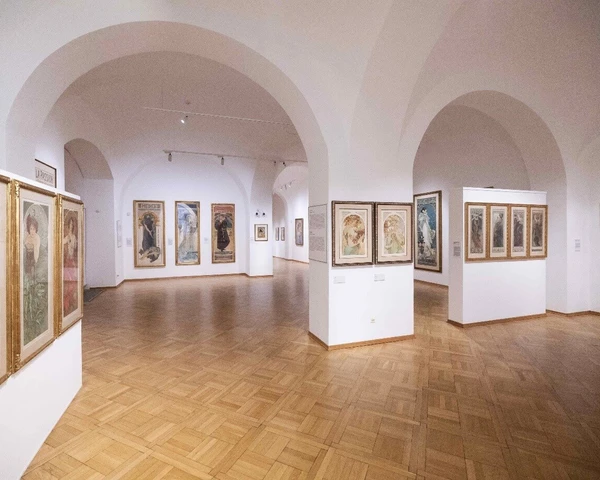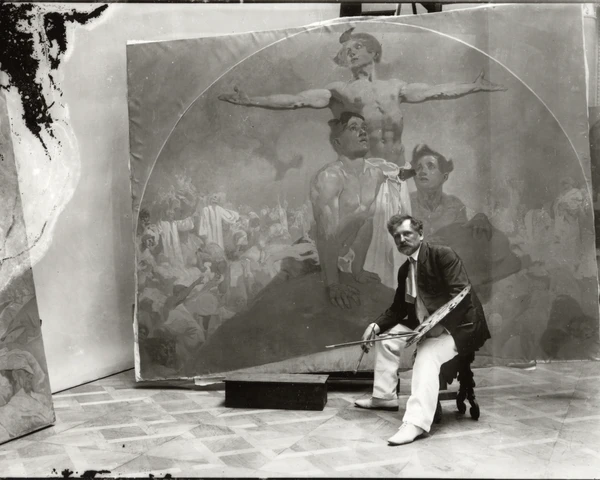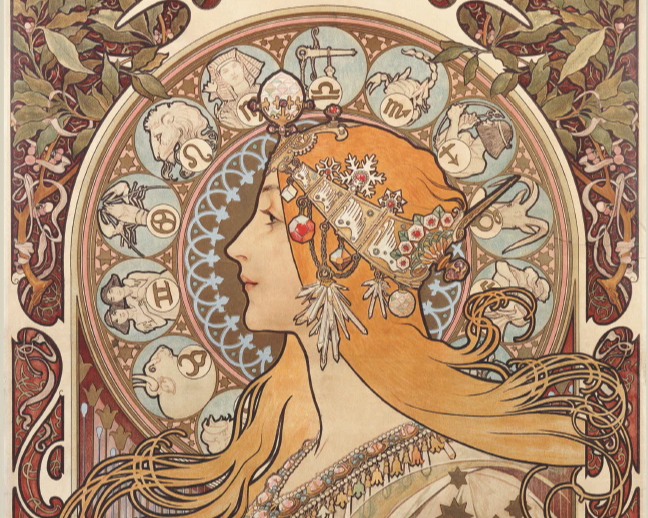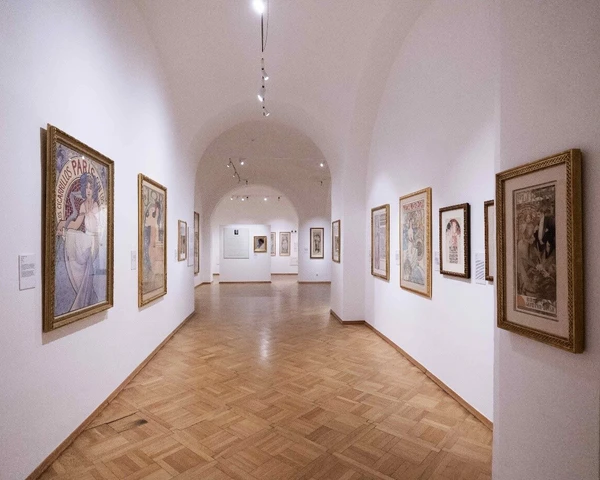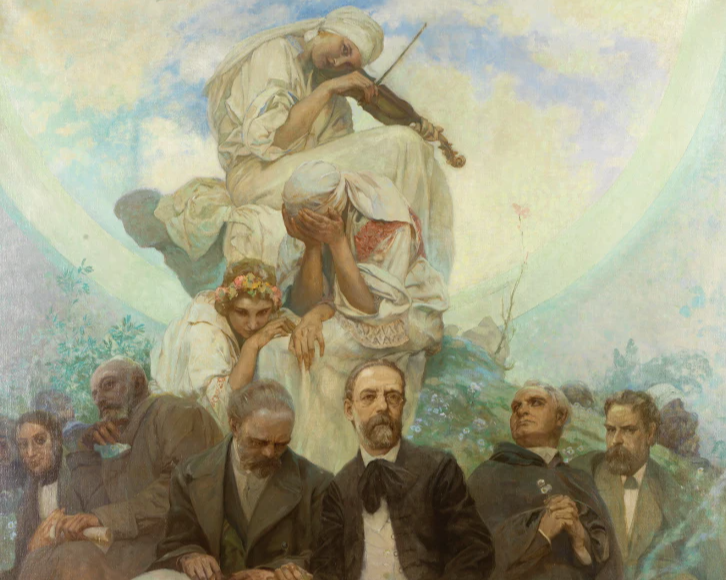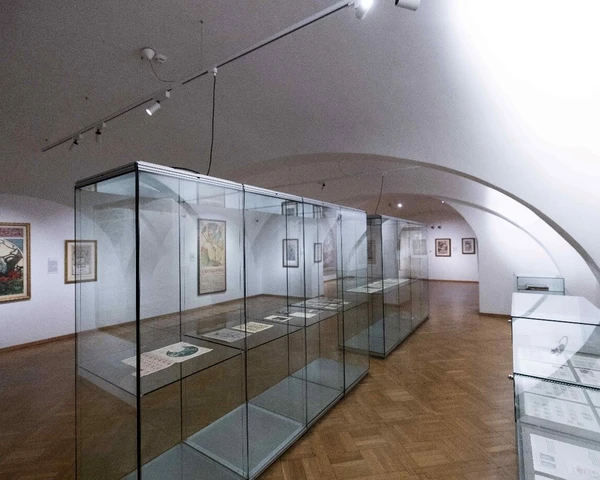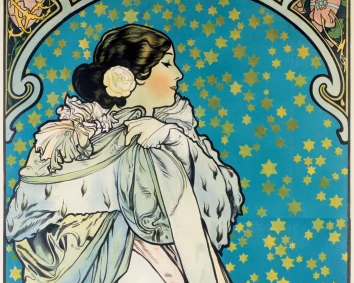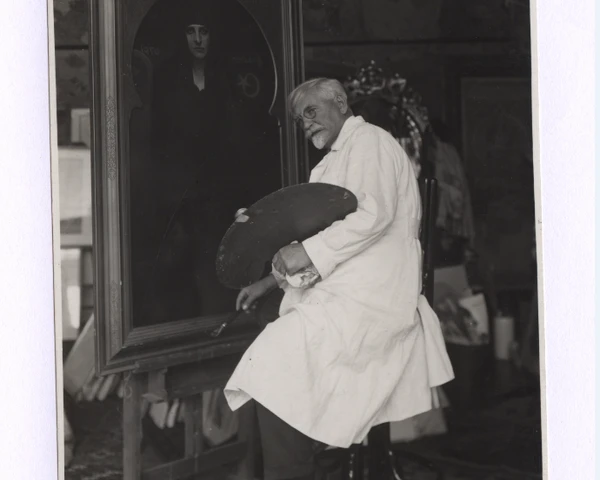
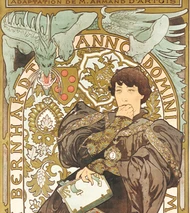
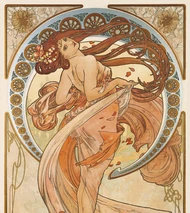
Exposition
Le musée Mucha
Exposition
Le musée Mucha — le premier musée original au monde consacré exclusivement à la vie et à l’œuvre du célèbre représentant de l’Art nouveau, Alfons Mucha (1860-1939) — ouvré au public à Prague le 13 février 1998. En septembre 2024, l’exposition est complétée par une nouvelle collection. Le musée Mucha expose aujourd’hui des œuvres majeures issues de la célèbre collection d’Ivan Lendl des œuvres de Mucha, sous la direction de Jack Rennert. La collection d’Ivan Lendl est actuellement détenue par Portu Gallery Investments, membre de WOOD&CO.
L’exposition présente des affiches de sa période parisienne et plusieurs de ses commandes commerciales les plus populaires, réalisées pour des sociétés telles que Moët & Chandon, les Cigarettes Job et les Biscuits Lefèvre-Utile.
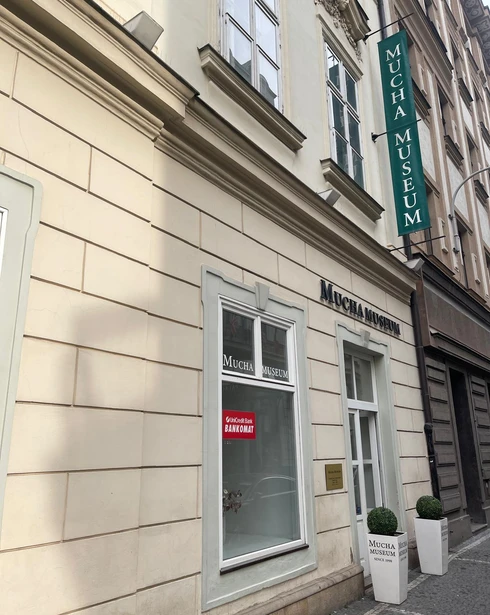
Le musée Mucha de la rue Panská est le seul endroit à Prague à n'exposer que des originaux.
Le musée présente toutes les pièces les plus importantes de la période parisienne d'Alfons Mucha et un grand nombre de ses commandes commerciales les plus populaires pour des sociétés telles que Moët & Chandon, Job Cigarettes, Lefèvre-Utile Biscuits, Nestlé et bien d'autres. Le musée a attiré plus de 2,6 millions de visiteurs au cours des 27 dernières années. Il ne faut pas le confondre avec un musée similaire qui a copié son nom et son concept et qui a récemment ouvert ses portes à proximité.
Muchovo Muzeum s.r.o est membre de l'Association des musées et galeries de la République tchèque et de l'Association tchèque pour l'intelligence artificielle.

Ce que vous pouvez attendre
L’exposition présente des affiches de sa période parisienne et plusieurs de ses commandes commerciales les plus populaires, réalisées pour des sociétés telles que Moët & Chandon, les Cigarettes Job et les Biscuits Lefèvre-Utile.
Le musée est divisé en cinq sections principale:
Panneaux décoratifs
Alfons Mucha est l’un des principaux représentants du style Art nouveau, qui repose sur la création d’un ensemble décoratif favorisant la répétition de motifs stylistiques. Mucha fonde son travail sur une image qui se prête à un arrangement en cycles inspirés de thèmes traditionnels, généralement issus du monde physique. C’est pour cette raison qu’il intitule sa première série de panneaux décoratifs, réalisée en 1896, Les Saisons. Il poursuit cette approche avec plusieurs autres séries à grand succès, respectant une variation en quatre ou en deux éléments autour d’un même thème, notamment Les Heures du jour (1899), ou Les Pierres précieuses (1900), datant d’une période où son style est déjà pleinement abouti. La combinaison stylisée de la nature et de figures féminines gracieuses représente l’expression de sa vision joyeuse de la vie, qui séduit particulièrement son public de l’époque. D’un point de vue artistique, la série Les Arts (1898) peut être considérée comme le plus élaboré de ces cycles, exécuté dans plusieurs techniques et se distinguant surtout par la qualité poétique des dessins de Mucha. La dernière œuvre des panneaux de Mucha présentée ici est sa série La Lune et les étoiles (1902). Par rapport aux autres cycles, celui-ci représente des figures plus dramatiques que sensuelles.

Les Saisons
La première série de panneaux décoratifs, Les Saisons, n’était pas une idée nouvelle. L’imprimeur Champenois l’avait déjà produite avec d’autres artistes, mais Mucha insuffle tant de vie au thème qu’elle devient l’une des séries de panneaux décoratifs les plus vendues.
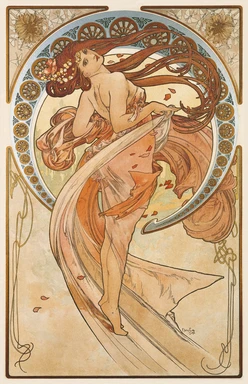
Les Arts
Dans son cycle glorifiant les quatre arts, Mucha choisit délibérément de s’affranchir des attributs traditionnels, tels que les plumes, les instruments de musique ou les accessoires du peintre. Il place chaque art sur un fond lié à un moment de la journée : le matin pour la danse, le midi pour la peinture, le soir pour la poésie et la nuit pour la musique.
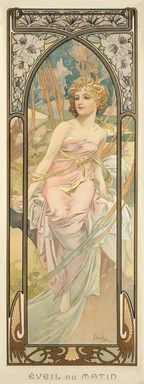
Les Heures du jour
Quatre figures féminines représentent les moments de la journée, chacune placée dans un environnement naturel encadré par une composition élaborée rappelant les fenêtres gothiques.
Affiches parisiennes
Les affiches réalisées à Paris dans les années 1890 constituent le segment le plus connu et le plus répandu de l’œuvre de Mucha. C’est grâce à elles qu’il réussit à imposer sa propre interprétation du nouveau style décoratif. Le premier groupe est constitué d’affiches pour Sarah Bernhardt, célèbre actrice parisienne. La première, créée au tournant des années 1894 et 1895, met en scène Sarah Bernhardt dans le rôle de Gismonda. Les esquisses et épreuves existantes de cette affiche montrent, à travers sa conception stylistique et surtout son usage des couleurs, la recherche intensive de Mucha pour renouveler l’image de l’affiche, malgré le délai très court imposé par cette commande. Sa révolution artistique apporte une élégance nouvelle au « salon de rue », jusqu’alors dominé par des affiches aux couleurs vives, renforçant ainsi l’importance croissante de l’affiche dans l’art moderne. Les affiches de Sarah Bernhardt comprennent aussi des tonalités dramatiques, comme dans Médée (1898), et il la représente également dans ses rôles masculins, notamment Lorenzaccio (1896) et Hamlet (1899). Deux variantes de La Dame aux camélias, une pièce très populaire sur le sacrifice par amour, sont également exposées. La dernière affiche parisienne est un portrait du Christ pour la pièce La Passion (1904). Toutes ces œuvres témoignent de l’extraordinaire ingéniosité de Mucha et de son sens aigu de la forme visuellement percutante.
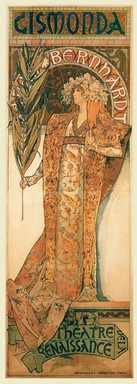
Gismonda
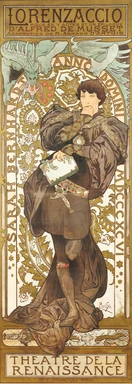
Lorenzaccio
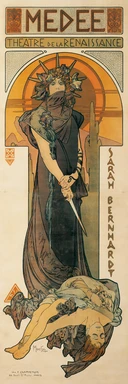
Médéa
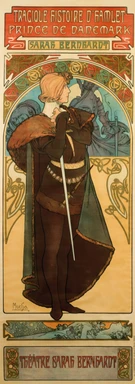
Hamlet
Gismonda
L’affiche qui rendit Mucha célèbre. L’histoire de sa création est entrée dans la légende, bien que certains commentateurs contestent certains détails. Il ne fait aucun doute que Mucha lui-même a vu la main du destin agir dans les circonstances qui l’ont amené à créer l’affiche.
L’histoire se déroule à Noël 1894. L’artiste, rendant service à un ami, corrige des épreuves chez l’imprimeur Lemercier lorsque Sarah Bernhardt appelle l’imprimerie pour commander d’urgence une nouvelle affiche pour la pièce de Gismonda. Tous les artistes travaillant habituellement pour Lemercier étant en congé, il se tourne vers Mucha. La commande de « la divine Sarah » ne peut être ignorée. L’affiche réalisée par Mucha est révolutionnaire dans son genre. Sa forme allongée, ses douces couleurs pastel et la quiétude de la figure presque grandeur nature introduisent un sentiment de dignité et de sobriété tout à fait surprenante. L’affiche devint si populaire auprès du public parisien que certains collectionneurs soudoyaient les colleurs d’affiches pour s’en procurer, ou sortaient la nuit pour les découper sur les panneaux d’affichage.
Sarah Bernhardt est enchantée par l’affiche et propose immédiatement à Mucha un contrat de six ans pour la réalisation de décors, de costumes et d’affiches. À la même époque, l’artiste signe un contrat d’exclusivité avec l’imprimeur Champenois pour la réalisation d’affiches commerciales et décoratives.

Lorenzaccio
Dans Lorenzaccio, une pièce d’Alfred de Musset, Sarah Bernhardt incarne le héros masculin, Lorenzo de Médicis, lors du siège de Florence par le tyran, le duc Alexandre, symboliquement représenté sur l’affiche par un dragon menaçant les armoiries florentines. Lorenzo contemple le meurtre d’Alexandre, qui est représenté dans le panneau au bas de l’affiche.
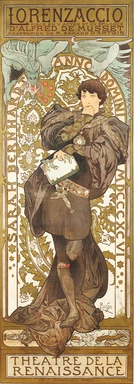
Médée
Le dramaturge Catulle Mendes a adopté le texte classique d’Euripide spécialement pour Sarah Bernhardt. Il y dépeint le héros grec, Jason, jusqu’alors perçu comme un idéal mythologique intouchable, sous les traits d’un trompeur sans scrupules qui trahit tous ceux qui l’aiment dans la poursuite de ses passions égoïstes, donnant ainsi à Médée la justification psychologique de ses terribles crimes. L’affiche rend compte de la substance de la tragédie à travers sa figure solitaire. Le fond en mosaïque et l’utilisation de la lettre grecque « D » situent la pièce dans l’Antiquité. Le regard de Médée, plein d’horreur, est fixé sur le poignard brillant qu’elle tient à la main, taché du sang de ses enfants qui gisent à ses pieds. Les mains exceptionnellement détaillées et le bracelet en forme de serpent qui orne l’avant-bras de Médée sont tout à fait remarquables. Ce dernier a été conçu par Mucha pendant qu’il travaillait sur l’affiche, et Sarah Bernhardt l’apprécia tellement qu’elle demanda au joaillier George Fouquet de réaliser un bracelet et une bague serpent incrustés de pierres précieuses pour les porter sur scène.
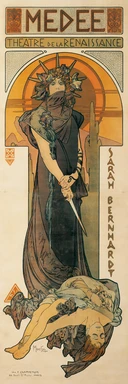
Hamlet
Sarah Bernhardt interpréta le héros masculin dans Hamlet de Shakespeare, traduit en français pour elle par Eugène Morand et Marcel Schwob. Derrière le personnage central d’Hamlet, apparaît en arrière-plan le fantôme de son père assassiné, qui hante les remparts d’Elseneur. Dans le panneau au pied de Hamlet gît Ophélie noyée, entourée de fleurs. Hamlet est la dernière affiche que Mucha réalise pour Sarah Bernhardt.
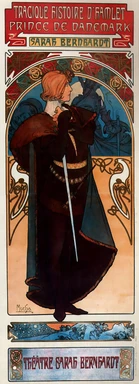
Affiches publicitaires
Le travail commercial d’Alfons Mucha est au cœur de sa renommée, en particulier ses affiches pour des produits et des marques à la Belle Époque. Sa percée a lieu en 1894 avec l’affiche Gismonda pour l’actrice Sarah Bernhardt, citée plus tôt, qui donne lieu à des commandes de la part de grandes entreprises telles que **Moët & Chandon**, **Cigarettes Job** et **Biscuits Lefèvre-Utile**. L’affiche la plus impressionnante de cette section est une commande de Nestlé — Hommage respectueux de Nestlé (1897) —, cadeau offert à la reine Victoria pour célébrer ses 60 années de règne. Les affiches de Mucha représentent des figures féminines élégantes et élancées, entourées de motifs floraux et de lignes fluides, incarnant le style Art nouveau. Ses créations rehaussent les produits de tous les jours et les rendent synonymes de beauté et de luxe. Cependant, outre les publicités de produits, ses commandes commerciales comprennent également des bannières pour des événements majeurs comme Paris 1900, l’exposition de Brooklyn en 1920 ou l’affiche Monaco-Monte-Carlo, encourageant les Parisiens à visiter la côte. Grâce à la lithographie, ces œuvres ont été produites en masse, combinant les beaux-arts à la publicité et façonnant ainsi les tendances marketing contemporaines.
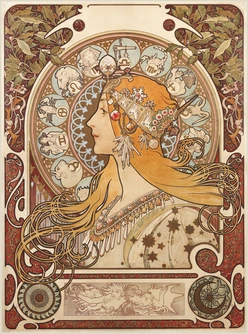
Zodiaque
L’un des dessins les plus populaires de Mucha, le Zodiaque, est produit à l’origine par Champenois comme calendrier de 1897. Le rédacteur en chef de La Plume apprécie tellement l’œuvre qu’il en achète les droits pour la distribuer en tant que calendrier du magazine pour la même année. Il existe au moins neuf variantes connues du Zodiaque, dont celle présentée ici qui a été imprimée sans texte pour servir de panneau décoratif.
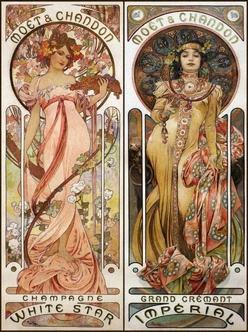
Moët & Chandon
Mucha exécute un certain nombre de dessins pour la société Moët & Chandon, utilisés sur des menus, des cartes postales et d’autres supports publicitaires. Deux de ses commandes sont consacrées à des affiches publicitaires, l’une pour le Blanc de Blancs, l’autre pour le Dry Impérial.
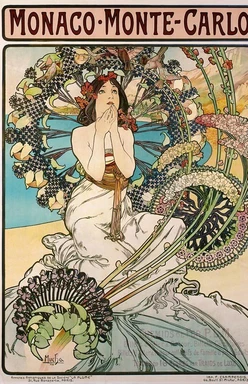
Monaco Monte-Carlo
Mucha conçoit ici une œuvre d’une grande richesse. Une jeune femme timide, agenouillée et captivée par le calme de la baie de Monte-Carlo, est entièrement entourée par des tiges incurvées de lilas et d’hortensias, dont les pétales sont parmi les plus délicats que Mucha ait jamais peints. Étant donné que le commanditaire de l’affiche était une compagnie ferroviaire (Chemin de fer P.L.M.), il est probable que le design évoque les rails et les roues qui transportent les voyageurs vers Monte-Carlo.
Affiches tchèques
Après son retour définitif dans son pays natal en 1910, Alfons Mucha renoue avec son profond désir de mettre son art au service de son peuple, exprimant à travers ses œuvres leurs aspirations et idéaux. Peu à peu, une nouvelle série d’affiches apparaît, se distinguant nettement des affiches parisiennes. Sur le plan thématique, on retrouve principalement une nouvelle approche d’un motif folklorique, mettant en valeur la richesse colorée des costumes traditionnels moraves et la douceur du type féminin slave, incarnée ici par le Chœur des enseignants moraves (1911). Il reçoit un contrat pour la banque d’assurance mutuelle Slavia, basée à Prague, en 1907 alors qu’il est encore aux États-Unis. L’une des affiches les plus remarquables de cette période est celle de son œuvre monumentale, L’Épopée slave (1928), qui semble directement inspirée du tableau Le Serment d’Omladina sous le tilleul slave. Cette section se clôt sur une évocation lyrique de motifs parisiens avec Princesse Hyacinthe (1911).
Princesse Hyacinthe
L’affiche de Princesse Hyacinthe fait la promotion du ballet pantomime de Ladislav Novák et Oskar Nedbal, avec l’actrice populaire Andula Sedláčková. Le motif de la jacinthe revient dans tout le dessin, que ce soit dans les broderies des tissus, les somptueux bijoux en argent, ou encore le cercle symbolique tenu par la princesse.
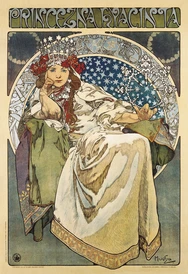
Le Chœur des enseignants moraves
Le Chœur des enseignants moraves était un ensemble choral interprétant un répertoire de musique classique, populaire et folklorique, notamment des compositions de Leoš Janáček. Le chœur a effectué des tournées dans les pays tchèques ainsi qu’en Europe et aux États-Unis. L’affiche représente une jeune femme portant un costume traditionnel de la région de Kyjov, dans une écoute attentive. Sa figure rappelle le panneau décoratif Musique de la série Les Arts.
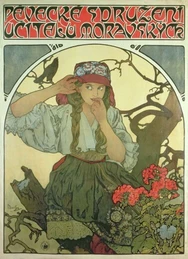
Panthéon de la musique tchèque
Cette huile sur toile originale est un peu mystérieuse. Selon Jiří Mucha, le fils de l'artiste, elle a été reproduite comme une sorte de calendrier commémoratif, mais il semble peu probable que Mucha ait créé une peinture aussi élaborée dans un but aussi banal. Il est plus probable qu'elle ait été peinte à l'origine pour une occasion plus importante et que son utilisation en tant que calendrier ait été une réflexion après coup. Le tableau est une ode à plusieurs compositeurs bohémiens célèbres qui sont célébrés et illuminés par des anges admiratifs. L'homme barbu au centre est Bedřich Smetana (1824-1884), surtout connu pour son opéra La fiancée vendue et son poème symphonique romantique Vltava. À côté de lui, Antonín Dvořák (1841-1904), compositeur de la Symphonie du Nouveau Monde, tient un crayon et du papier ; de l'autre côté, dans une position respectueuse, se trouve Pavel Křížkovský (1820-1885), compositeur de musique chorale et sacrée et l'un des mentors de Mucha. À gauche de Dvořák se trouve Gottfried Rieger (1764-1855), compositeur et chef d'orchestre morave prolifique, et à l'extrême gauche, František Škroup (1801-1862), auteur de l'hymne national tchèque. À l'extrême droite se trouve Zdeněk Fibich, compositeur qui a créé une forme musicale mélodramatique.

Objets de collection
Dans cette section de l’exposition, vous aurez l’opportunité de découvrir les œuvres de plus petit format de Mucha. Alfons Mucha conçut une série de timbres, de billets de banque et d’autres symboles nationaux pour la Tchécoslovaquie, nouvellement formée à l’issue de la Première Guerre mondiale. Mucha, fier patriote, était profondément attaché à l’identité culturelle et politique de sa patrie. Ses dessins pour les timbres tchécoslovaques de 1918 constituent une contribution précieuse à l’émergence de la nation en tant qu’État indépendant après l’effondrement de l’Empire austro-hongrois. Les billets de banque, dont la conception a été confiée à Mucha en 1919, reflètent son style caractéristique, avec des lignes ornementales fluides et des motifs illustrant l’identité nationale. Parmi les autres pièces exposées figurent son Notre Père illustré, ainsi que des lettres personnelles et des cartes postales.

Billet de banque proposé par A.Mucha
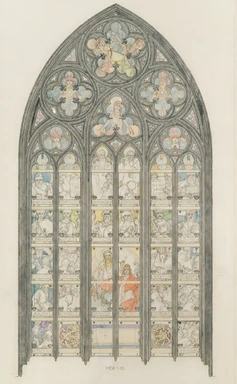
Vitraux de la cathédrale Saint-Guy à Prague
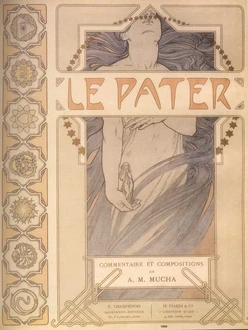
Le Pater
Le Pater
Mucha considérait Le Pater (prière du Notre Père) comme l’une de ses plus grandes œuvres. Elle est imprimée à Paris en 510 exemplaires numérotés (390 français et 120 tchèques) par Henri Piazza, à qui Mucha dédie l’œuvre.
À propos de Le Pater, Mucha écrit : « À l’époque, je voyais ma voie ailleurs, plus haut. Je cherchais un moyen de diffuser la lumière jusque dans les recoins les plus reculés. Je n’ai pas eu à chercher longtemps. Le Notre Père. Pourquoi ne pas exprimer son texte par des images ? »
Dans Le Pater, Mucha divise la prière en sept versets. Il analyse chaque verset dans une série de trois pages décoratives. Sur la première page, il présente les versets en latin et en français entourés d’une composition décorative qui incorpore des motifs géométriques et symboliques. Sur la deuxième page, Mucha commente le verset, imitant un manuscrit médiéval enluminé, notamment avec la lettre initiale ornée en couleur. La troisième page contient l’interprétation monochrome du verset par Mucha. Ces illustrations visionnaires représentent la lutte intérieure de l’homme sur la voie de l’obscurité à la lumière.

Où nous trouver
Kaunický palác, Panská 7
110 00 Prague 1
